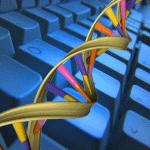Bioinformatics
|
21 april 2014 07:20:38 |
| Insights into a highly conserved network of hydrogen bonds in the agonist binding site of nicotinic acetylcholine receptors: A structural and theoretical study (Proteins: Structure, Function, and Bioinformatics) |
|
Tweet Structural and theoretical studies on the geometrical features of a hydrogen-bond network occurring in the binding site of nicotinic acetylcholine receptors (nAChRs) and composed of interconnected WxPD (Trp-x-Pro-Asp) and SWyz (Ser-Trp-yz) sequences from loops A and B, respectively, have been carried out. Multiple sequence alignments using as template the sequence of the apoform of Aplysia californica Acetylcholine binding protein (Ac-AChBP) show the strict conservation of Serine and Tryptophan residues of the loop B SWyz sequence. Considering a sample of 19 high resolution AChBP structures, the strong conformational preferences of the key Tryptophan residue has been pointing out, whatever the form, free or bounded, of AChBP. The geometry of the motif hydrogen-bond network has been characterised through the analyses of seven distances. The robustness of the various hydrogen-bond interactions is pointed out, the one involving the Aspartate carboxylate group and the Serine residue being the shortest of the network. The role of a cooperative effect involving a NH(His145)...OH(Ser142) hydrogen bond is highlighted. Density Functional Theory (DFT) calculations on several simplified models based on the motif hydrogen-bond network allow probing the importance of the various hydrogen-bond interactions. The removal of the Ser142 hydroxyl group induces strong structural rearrangements, in agreement with the structural observations. Molecular electrostatic potential calculations on model systems highlight the importance of a cooperative effect in the whole hydrogen-bond network. More precisely, the key role of the Ser142 hydroxyl group, involved in several hydrogen bonds, is underlined. © Proteins 2014;. © 2014 Wiley Periodicals, Inc. |
| 89 viewsCategory: Biochemistry, Bioinformatics |
 Importance of polarization effect in the study of metalloproteins: Application of polarized protein specific charge scheme in predicting the reduction potential of azurin (Proteins: Structure, Function, and Bioinformatics) Importance of polarization effect in the study of metalloproteins: Application of polarized protein specific charge scheme in predicting the reduction potential of azurin (Proteins: Structure, Function, and Bioinformatics)Structural dynamics of the monoamine transporter homologue LeuT from accelerated conformational sampling and channel analysis (Proteins: Structure, Function, and Bioinformatics) 
|
| blog comments powered by Disqus |
MyJournals.org
The latest issues of all your favorite science journals on one page
The latest issues of all your favorite science journals on one page



